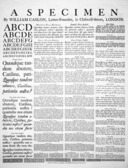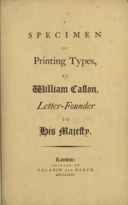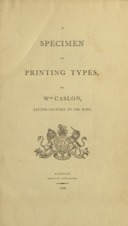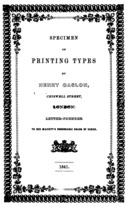London. William Caslon. Successors by various names. 1720-1937. Acquired by Stephenson, Blake & Co. But see also Caslon Ltd.
The history of this foundry is complicated.
1720. Founded by William Caslon (1692-1766).
William Caslon trained Joseph Jackson, and Thomas Cottrell. Both went on to form foundries which became important firms. (Jackson's was acquired by Caslon III and later merged into Stephenson, Blake. Cottrell's became the Fann Street Foundry, one of the mainstays of Victorian British typecasting until its acquisition in 1905 by Stephenson, Blake.
1742. William Caslon II (1720-1778) admitted to partnership. Trading as William Caslon & Son.
William Caslon III (1754-1833) "succeeded to management" (presumably in 1778). He owned the foundry jointly with his mother, the widow of William Caslon II (Mrs. William Caslon (Eliz. Caslon, ? - 1795) and his brother, Henry Caslon I.
Henry Caslon I died in 1788 and his interest passed to his widow, Mrs. Henry Caslon I.
In 1792, William Caslon III sold out his interests "to his mother and his brother Henry's widow, and bought the foundry of the deceased Joseph Jackson." He (and presumably his son William Caslon IV, at that time a minor, left the main family Caslon business and began to run the foundry started by Joseph Jackson under his own name, William Caslon III. Caslon III and Caslon IV play no further part in the history of the main family business.
So, confusingly, in 1792 there are two Caslon foundries:
One should note that "running" means running. Mrs. William Caslon III, especially, was a respected member of the business community. { Moseley, James, Justin Howes, and Nigel Roche. Founder's London A-Z. (London: The [European] Friends of the St. Bride's Printing Library, 1998) , p. 27}, reproduces a page of signatures from the Minute Book of the Association of Typefounders, 1793, where "Eliz. Caslon" and what I presume is the signature of Mrs. Henry Caslon I appear together with those of Fry, Figgins, and Stephenson.
1795. Mrs. William Caslon II (Eliz. Caslon) died intestate.
1799. Mrs. Henry Caslon I (who presumably was actually running the foundry whilst it was in chancery) purchases the foundry. She takes on Nathaniel Catherwood as a partner.
1809. Mrs. Henry Caslon I dies in March. Firm continues very briefly under the sole management of Nathaniel Catherwood, who dies in June. Henry Caslon II takes over.
1814. John J. Catherwood admitted to partnership with Henry Caslon II.
1821. J. J. Catherwood leaves (he goes to Anthony Bessemer). Martin William Livermore admitted to partnership.
At some point by 1839, Henry William Caslon (Henry Caslon II's son) admitted to partnership. An 1839 specimen from "Caslon, Son & Livermore."
1846. Reed notes a failed attempt to sell the foundry. It continues as Caslon & Son. (Does this mean that Livermore died or left the partnership?)
1850. Henry Caslon II dies. Foundry also acquires the two branches (the London branch, which was formerly the Glasgow branch, and the Two-Waters, Hertfordshire branch) of the Alexander Wilson foundry (the Glasgow Letter Foundry). Henry William Caslon continues as manager of Caslon & Son. Mr. Wilson [which one?] joins Caslon & Son for a period as a manager.
N.B. the Edinburgh and Dublin branches of Alexander Wilson were purchased by James Marr, who continued them under his own name. It is a matter of interpretation to decide which branch, Caslon or Marr, represents the "continuation" of Alexander Wilson.
1874. Henry William Caslon dies. Business continues under the same name (H. W. Caslon & Co.), but the owners are T. W. Smith and partners.
1900-1937. H. W. Caslon & Co. Ltd.
Several sources note that they were acquired by Stephenson, Blake & Co. in 1937. Millington goes further and notes that Stephenson, Blake acquired Caslon's "goodwill, punches, matrices, and stock [of type]"
I do not know if this wrapped up the Caslon family business. The present firm of Caslon Limited traces its lineage back to Caslon I.
Reed, Talbot Baines. A History of the Old English Letter Foundries. London: Elliot Stock, 1887.

This specimen is, originally, from Ephriaim Chambers' Cyclopædia: or, An Universal Dictionary of Arts and Sciences (London, 1728). This image itself is from Wikipedia/Wikimedia Commons: http://en.wikipedia.org/wiki/File:Caslon-schriftmusterblatt.jpeg and is in the public domain.

1785. A Specimen of Printing Types
A Specimen of Printing Types by William Caslon, Letter-Founder to His Majesty . (London: [Printed by] Galabin and Baker, 1785.) The William Caslon of the title must be William Caslon III, who managed the firm from 1778 until he sold out his interests in 1792.
A digital version of this book, including the original page scans, is available at The Internet Archive; the link at left goes there. Here is a local copy of the PDF version and the (nicer) DjVu version.

1796. A Specimen of Printing Types
A Specimen of Printing Types by William Caslon, Letter-Founder to the King . (London: C. Whittingham, 1796.)
A digital version of this book, including the original page scans, is available at The Internet Archive; the link at left goes there. Here is a local copy of the PDF version and the (nicer) DjVu version.

1798. A Specimen of Printing Types
A Specimen of Printing Types by William Caslon, Letter-Founder to the King . (London: C. Whittingham, 1798.)
A digital version of this book, including the original page scans, is available at The Internet Archive; the link at left goes there. Here is a local copy of the PDF version and the (nicer) DjVu version.

1841. Specimen of Printing Types
Specimen of Printing Types by Henry Caslon, Chisell Street, London: Letter-Founder to Her Majesty's Honorable Board of Trade . (London: [H. W. Caslon], 1841.)Digitized by Google Books (q.v.) The link here is to a local copy of the Google Books digitization.
All of the specimen books reproduced here or from which images are reproduced here are in the public domain. Any material from them reproduced here remains in the public domain.
All portions of this document not noted otherwise are Copyright © 2011 by David M. MacMillan and Rollande Krandall.
Circuitous Root is a Registered Trademark of David M. MacMillan and Rollande Krandall.
This work is licensed under the Creative Commons "Attribution - ShareAlike" license. See http://creativecommons.org/licenses/by-sa/3.0/ for its terms.
Presented originally by Circuitous Root®
Select Resolution: 0 [other resolutions temporarily disabled due to lack of disk space]